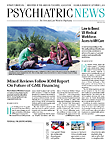An estimated 26.8 million adults in the United States use prescription medications for psychiatric disorders, according to the Substance Abuse and Mental Health Services Administration, but use of these important treatments can sometimes lead to adverse consequences that culminate in an emergency department (ED) visit.
So researchers from the Centers for Disease Control and Prevention (CDC) and Johns Hopkins Bloomberg School of Public Health wanted to discover how often use of psychotropic drugs leads to an ED visit. They describe their findings in the July 9 JAMA Psychiatry and show not only the rate at which medications used to treat mental illness can lead to the ED, but they also suggest that efforts should focus on reducing the adverse effects of these drugs.
“These are not simple medicines to prescribe,” said Alan Schatzberg, M.D., a professor of psychiatry at Stanford University School of Medicine, who was not involved in the study. Schatzberg, a past APA president, told Psychiatric News that it’s important for any clinician who prescribes drugs that fall into the category of “psychiatric medicines” to keep abreast of the literature regarding use of such medicines to effectively monitor patients for adverse events. “A high level of competence for prescribing psychiatric drugs is required by doctors—especially psychiatrists,” he emphasized.
In the current study, which analyzed data from 63 hospitals participating in the National Electronic Injury Surveillance System–Cooperative Adverse Drug Event Surveillance, the researchers analyzed medical records of adults aged 19 and older who were treated at least once at an ED from January 2009 to December 2011 for an adverse event related to psychiatric drugs.
The results showed that psychiatric medication accounted for an estimated 89,094 annual ED visits for adverse events in the three years studied—with about 1 in 5 of the visits resulting in hospital admission
Nearly 50 percent of ED visits related to psychiatric drugs involved adults aged 19 to 44, while 17 percent involved patients aged 65 and older. Adverse events related to antipsychotics and antidepressants were the leading medication-related causes of ED visits among the young to middle-aged adults, whereas adverse events linked to use of sedative and anxiolytic medications were the leading cause of ED visits for the older adults. Women aged 19 to 44, were most likely to visit the ED for adverse events associated with antidepressants, while men were more likely to be treated for adverse events involving antipsychotics.
Overall, after age and gender factors were removed from the analysis, the researchers found lithium salts and antipsychotics to be the leading contributors to ED visits related to psychiatric medication use. The most common adverse consequences were movement disorders such as dystonia and extrapyramidal disorders, which were linked to antipsychotic use.
“These findings provide the first detailed estimates of the annual number of adult emergency department visits due to adverse effects from therapeutic use of antipsychotics, antidepressants, lithium salts, stimulants, and sedatives/anxiolytics,” said lead author Lee Hampton, M.D., MSc., a medical officer with the Division of Healthcare Quality Promotion at the CDC, in an interview with Psychiatric News. “Antipsychotics caused three times more ED visits for adverse drug events than sedatives . . . and almost five times more ED visits than antidepressants.”
In a commentary published on Medscape, Hampton noted that the study’s results also support the recommendations highlighted last year by APA in the “Choosing Wisely” campaign about use of antipsychotics, which emphasized that while these medications have tremendous benefits, they also can have serious side effects and thus should be prescribed with caution to ensure that their use is clinically warranted (Psychiatric News, October 31, 2013).
Hampton and colleagues concluded that more aggressive efforts should be implemented to reduce adverse events associated with psychiatric medications among adults of all ages, starting with greatest priority given to the medications that this study found were linked with the highest rates of ED visits. ■
An abstract of “Emergency Department Visits by Adults for Psychiatric Medication Adverse Events” can be accessed
here.

